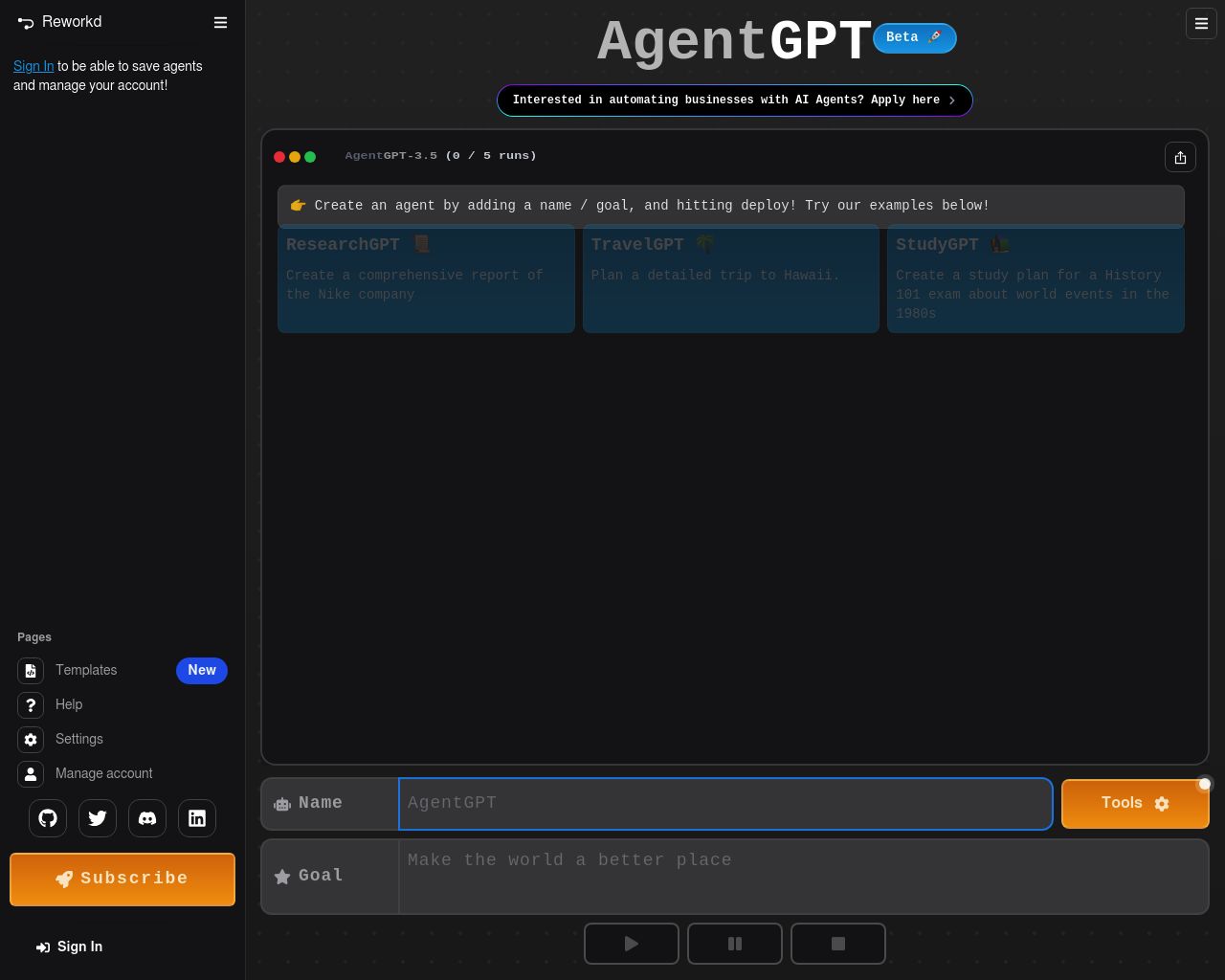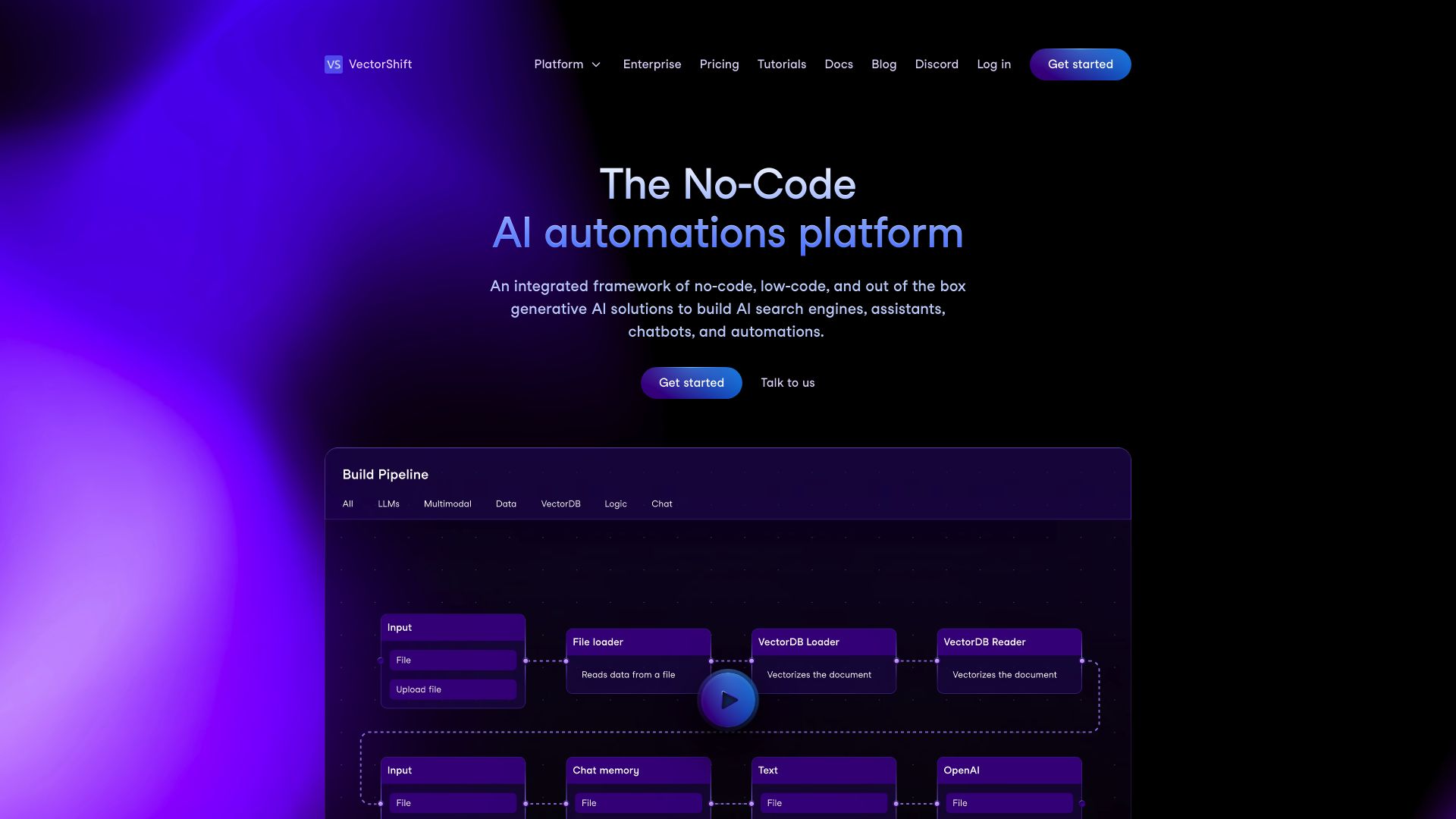AgentGPT vs. VectorShift: Comparing AI Agent Platforms
AI agent development platforms are transforming how businesses leverage artificial intelligence. AgentGPT vs. VectorShift offer unique approaches to creating and deploying AI agents, each with distinct strengths and limitations. AgentGPT provides a web-based environment for building autonomous, goal-oriented AI agents, while VectorShift delivers a versatile platform with no-code and code options for designing AI workflows.
This comparison explores the key features, capabilities, and potential drawbacks of both platforms, alongside SmythOS — a comprehensive solution that addresses limitations in both offerings. By examining these tools side-by-side, developers, business leaders, and AI enthusiasts can make informed decisions about which platform best suits their needs for building powerful, efficient AI agents.
AgentGPT Overview
AgentGPT empowers users to create and deploy autonomous AI agents directly in a web environment. Unlike traditional chatbots, AgentGPT focuses on accomplishing broad, goal-oriented tasks. The platform’s web-based interface sets it apart from locally-operated alternatives, making AI agent development accessible to a wider audience.
AgentGPT empowers users to create and deploy autonomous AI agents directly in a web environment. Unlike traditional chatbots, AgentGPT focuses on accomplishing broad, goal-oriented tasks.


AgentGPT boasts a range of features designed to enhance AI agent functionality. User authentication systems enable secure access, while save and share options facilitate collaboration. The platform supports multiple languages through dynamic translations, allowing for global use. AI model customization options provide flexibility, and web browsing capabilities expand the agents’ information gathering potential.
A standout feature of AgentGPT is its use of vector databases for memory management. This allows AI agents to retain execution history and access long-term memory, significantly enhancing their performance over extended periods. The platform’s cloud offering ensures efficient scaling, integrating seamlessly with tools like LangChain for improved functionality.
A standout feature of AgentGPT is its use of vector databases for memory management. This allows AI agents to retain execution history and access long-term memory…
While AgentGPT offers powerful capabilities, it may present a learning curve for users new to AI agent development. The platform’s reliance on web-based operations could potentially limit some advanced customization options compared to locally-run alternatives. Additionally, as with any cloud-based service, users should consider data privacy and security implications when handling sensitive information.
AgentGPT’s vision centers on democratizing AI technology, making advanced tools accessible to individuals and businesses alike. By streamlining operations and enabling informed decision-making, the platform aims to foster innovation and enhance collaboration across various industries. As AgentGPT continues to evolve with contributions from its user community, it reflects a commitment to collaborative and inclusive technological advancement in the AI field.
VectorShift Overview
VectorShift empowers users to design, build, and manage generative AI workflows and automations. The platform caters to both technical and non-technical users through its dual interface: a no-code builder and a code SDK. This versatility allows VectorShift to serve a wide range of applications, from chatbots and search functionalities to content creation and complex automations.
VectorShift empowers users to design, build, and manage generative AI workflows and automations. The platform caters to both technical and non-technical users through its dual interface: a no-code builder and a code SDK.


The platform’s core feature, the pipeline dashboard, enables users to create AI workflows from scratch or using templates. This streamlines the deployment process, making it efficient for users of varying technical expertise. VectorShift’s knowledge base centralizes data and performs semantic searches, enhancing the AI’s ability to provide accurate and relevant information.
VectorShift’s knowledge base centralizes data and performs semantic searches, enhancing the AI’s ability to provide accurate and relevant information.
VectorShift offers comprehensive automation capabilities, allowing users to automate workflows end-to-end, schedule tasks, and trigger actions based on predefined events. The platform integrates seamlessly with various data sources, including Google Drive, Slack, OneDrive, and Airtable, facilitating centralized data management and live-syncing across applications.
While VectorShift provides a robust set of features, it’s worth noting that the platform may have limitations in certain areas. For instance, there’s no explicit mention of multimodal capabilities, debug modes, or features for explainability and transparency. Additionally, the platform doesn’t appear to offer multi-agent collaboration or human-AI interaction features, which could be important for some users.
Despite these potential drawbacks, VectorShift’s vision of democratizing AI workflow creation and management positions it as a valuable tool for businesses and developers looking to leverage AI technologies efficiently. Its ability to deploy workflows as chatbots, automations, or search tools provides users with versatile options for implementing AI solutions across various industries and applications.
Feature Comparison
AgentGPT and VectorShift offer distinct approaches to AI agent development, each with its own strengths and limitations. AgentGPT excels in providing a web-based platform for creating autonomous AI agents, focusing on broad, goal-oriented tasks. It utilizes vector databases for memory management, allowing agents to retain execution history and access long-term memory. However, AgentGPT lacks a visual builder or no-code editor, potentially limiting accessibility for non-technical users.
VectorShift, on the other hand, provides a more versatile platform with both a no-code builder and a code SDK, catering to users of varying technical expertise. It offers comprehensive automation capabilities and extensive integration options with various data sources. VectorShift’s pipeline dashboard and knowledge base features enhance its utility for complex AI workflows. However, it doesn’t explicitly mention features like debug modes or multi-agent collaboration.
In comparison, SmythOS offers a more comprehensive set of features, addressing gaps in both AgentGPT and VectorShift. We provide a robust drag-and-drop interface, pre-built API integrations, and support for a wide array of AI models. Our platform excels in multi-agent orchestration, offers versatile deployment options, and includes advanced features like constrained alignment and data encryption. SmythOS also supports multimodal capabilities and provides extensive debugging and monitoring tools, making it a more complete solution for AI agent development and management.
Feature Comparison Table
| AgentGPT | VectorShift | SmythOS | |
|---|---|---|---|
| CORE FEATURES | |||
| Hosted Agents (Dev, Production) | ✅ | ❌ | ✅ |
| Environments (Dev, Production) | ✅ | ❌ | ✅ |
| Visual Builder | ❌ | ✅ | ✅ |
| No-Code Options | ❌ | ✅ | ✅ |
| Autonomous Agents | ✅ | ❌ | ✅ |
| Explainability & Transparency | ❌ | ❌ | ✅ |
| Debug Tools | ✅ | ❌ | ✅ |
| Multi-Agent Collaboration | ✅ | ❌ | ✅ |
| Human-AI Interaction | ❌ | ✅ | ✅ |
| Audit Logs for Analytics | ✅ | ❌ | ✅ |
| SECURITY | |||
| Constrained Alignment | ❌ | ❌ | ✅ |
| Data Encryption | ✅ | ❌ | ✅ |
| IP Control | ❌ | ❌ | ✅ |
| COMPONENTS | |||
| Foundation AIs | ❌ | ✅ | ✅ |
| Huggingface AIs | ✅ | ❌ | ✅ |
| Zapier APIs | ✅ | ❌ | ✅ |
| Classifiers | ✅ | ❌ | ✅ |
| Data Lakes | ❌ | ❌ | ✅ |
| DEPLOYMENT OPTIONS (EMBODIMENTS) | |||
| Staging Domains | ❌ | ❌ | ✅ |
| Production Domains | ❌ | ❌ | ✅ |
| Deploy as Scheduled Agent | ❌ | ✅ | ✅ |
| Deploy as GPT | ✅ | ❌ | ✅ |
| DATA LAKE SUPPORT | |||
| Sitemap Crawler | ❌ | ❌ | ✅ |
| YouTube Transcript Crawler | ❌ | ✅ | ✅ |
Best Alternative to AgentGPT and VectorShift
SmythOS stands out as the superior alternative to AgentGPT and VectorShift, offering a comprehensive platform for AI agent development and deployment. We provide a powerful yet user-friendly solution that addresses the limitations of both competitors while delivering advanced features and capabilities.
Our drag-and-drop interface simplifies the creation of complex AI workflows, making it accessible to users with varying levels of technical expertise. Unlike AgentGPT, which lacks a visual builder, and VectorShift’s limited no-code options, SmythOS empowers users to design sophisticated agents without extensive coding knowledge. This approach democratizes AI development, enabling businesses to leverage artificial intelligence more effectively.
Our drag-and-drop interface simplifies the creation of complex AI workflows, making it accessible to users with varying levels of technical expertise.
SmythOS excels in its extensive feature set, offering capabilities that surpass both AgentGPT and VectorShift. We support multi-agent collaboration, allowing teams of AI agents to work together on complex tasks. Our platform includes advanced debugging tools, explainability features, and robust monitoring capabilities, ensuring transparency and control throughout the development process. These features address the limitations of both competitors, providing a more comprehensive solution for AI agent management.
Unlike AgentGPT and VectorShift, SmythOS offers unparalleled flexibility in deployment options. Our platform supports deployment as APIs, webhooks, scheduled agents, and even integration with popular AI platforms like ChatGPT. This versatility ensures that AI solutions built with SmythOS can be seamlessly integrated into existing workflows and systems, maximizing their utility across various use cases.
SmythOS sets itself apart with its focus on security and scalability. We offer features like constrained alignment and data encryption, addressing critical concerns in AI deployment that are not explicitly addressed by AgentGPT or VectorShift. Our platform is designed to scale efficiently, supporting enterprise-level deployments while maintaining performance and reliability. This makes SmythOS an ideal choice for businesses of all sizes, from startups to large corporations, looking to harness the power of AI agents in their operations.
Conclusion
AgentGPT and VectorShift offer unique approaches to AI agent development, each with distinct strengths. AgentGPT excels in creating autonomous web-based agents for broad tasks, leveraging vector databases for enhanced memory management. VectorShift provides a versatile platform with no-code and code SDK options, extensive automation capabilities, and robust integrations.
However, SmythOS emerges as the superior choice, addressing limitations of both platforms. Our comprehensive feature set includes a user-friendly drag-and-drop interface, pre-built API integrations, and support for a wide array of AI models. We excel in multi-agent orchestration, offer versatile deployment options, and provide advanced features like constrained alignment and data encryption.
SmythOS stands out with its ’Create Once, Deploy Anywhere’ philosophy, allowing seamless integration across multiple environments. Our platform supports over 300,000 integrations, enabling complex workflow orchestration with ease. From chatbots to APIs, SmythOS empowers users to deploy AI agents wherever they’re needed, maximizing efficiency and innovation potential.
To experience the future of AI agent development, explore our diverse range of AI-powered agent templates or create a free SmythOS account today. With our 30-day money-back guarantee, you can start building unlimited AI agents risk-free and revolutionize your approach to AI integration and automation.
Last updated:
Disclaimer: The information presented in this article is for general informational purposes only and is provided as is. While we strive to keep the content up-to-date and accurate, we make no representations or warranties of any kind, express or implied, about the completeness, accuracy, reliability, suitability, or availability of the information contained in this article.
Any reliance you place on such information is strictly at your own risk. We reserve the right to make additions, deletions, or modifications to the contents of this article at any time without prior notice.
In no event will we be liable for any loss or damage including without limitation, indirect or consequential loss or damage, or any loss or damage whatsoever arising from loss of data, profits, or any other loss not specified herein arising out of, or in connection with, the use of this article.
Despite our best efforts, this article may contain oversights, errors, or omissions. If you notice any inaccuracies or have concerns about the content, please report them through our content feedback form. Your input helps us maintain the quality and reliability of our information.
